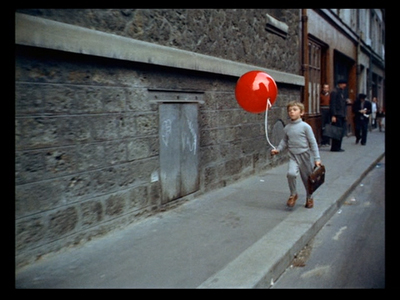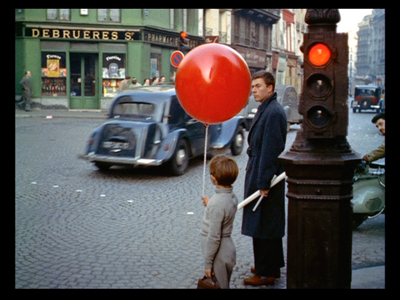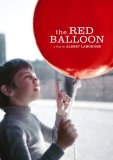| Reviews & Columns |
|
Reviews DVD TV on DVD Blu-ray 4K UHD International DVDs In Theaters Reviews by Studio Video Games Features Collector Series DVDs Easter Egg Database Interviews DVD Talk Radio Feature Articles Columns Anime Talk DVD Savant Horror DVDs The M.O.D. Squad Art House HD Talk Silent DVD
|
DVD Talk Forum |
|
|
| Resources |
|
DVD Price Search Customer Service #'s RCE Info Links |
|
Columns
|
|
|
Red Balloon, The
Other // G // April 29, 2008
List Price: $14.95 [Buy now and save at Amazon]
 Fifty years after its release, Albert Lamorisse's "The Red Balloon" ("Le Ballon Rouge") remains one of the most beloved of all short films. The key to its lasting endurance is in its simplicity - it's a fantastical story told in the most minimal of terms, with very few lines of dialogue, from a child's perspective. The lack of embellishment leaves it as something timeless. And yet behind its simplicity lies a mountain of metaphor that has kept critics, film majors, and fans talking for five decades.
Fifty years after its release, Albert Lamorisse's "The Red Balloon" ("Le Ballon Rouge") remains one of the most beloved of all short films. The key to its lasting endurance is in its simplicity - it's a fantastical story told in the most minimal of terms, with very few lines of dialogue, from a child's perspective. The lack of embellishment leaves it as something timeless. And yet behind its simplicity lies a mountain of metaphor that has kept critics, film majors, and fans talking for five decades.Many of you have already seen "The Red Balloon" and recognize its status as a classic. For you, no review is necessary - it remains as delightful an experience as the first time you watched it.
For the uninitiated, however, a primer: "The Red Balloon" is the tale of a young boy (played by the writer/director's son, Pascal Lamorisse) who frees a balloon that he finds tied to a lamppost; the balloon shows its gratitude by following the boy wherever he goes, which gets the boy into trouble at times. Later, other schoolboys try to grab the balloon for themselves.
And that's pretty much it. But what magic Lamorisse weaves with such a story. As the balloon, a vibrant sphere of red set against the dismal grays of the Ménilmontant section of Paris, floats along, it genuinely seems alive, bobbing and weaving in a playful manner, like a puppy. Lamorisse's crew used a variety of puppeteering techniques, most of which still remain invisible. (The clarity of DVD finally reveals the thin string in a few shots, but even then you have to be looking for it - an act which defies the very whimsical nature of the film.) The balloon's behavior, created through a blend of marionette and mime, leads us to opening our hearts to this lively creature.
It's such a gentle experience, a soothing children's picture book come to life. The boy and his new friend engage in a series of almost non-adventures: a trip to the bakery, a stop at a street market, a chance to flirt with a girl's blue balloon. Reflecting the boy's previous experiences with the city, some grown-ups are grumpy authority types (the balloon prankishly torments a teacher in one scene), but most are benevolent helpers, eager to lend a hand, watching the balloon when the boy goes places his friend cannot. These are all lovely scenarios (the shot of the balloon regarding itself in the mirror while the boy studies a painting carries an unexpected emotional weight), and one can imagine a soft, soothing narrator calmly reading along with accompanying text. (Indeed, Lamorisse later released a book based on the film, which itself has become a favorite.)
The gentleness is then punctuated with Lamorisse's expertise with the camera. The filmmaker finds a visual sweetness in the location shots - even the scenes that offer no contrast between colorful balloon and colorless cityscape are pleasant to watch. Lamorisse then toys with camera movement; watch as the camera glides down the street, following the boy as he runs free through the city, desperate to make it to school on time. This is beautiful filmmaking.
Then the boys begin to attack the balloon with slingshots and rocks, and the gentleness disappears - the boys removed it with their rough, uncaring ways. (The director's camera amplifies this by offering tighter shots and faster cuts, a claustrophobic feel.) The analogies in this section of the film can go as deep as you like: the boy is ostracized by a public that does not understand him, a public that does not only want to capture the magic, but destroy it. Is this a religious allegory? A philosophical one? A warning to fellow outsider-types that the unwashed masses will never tolerate them? A statement on the crudity of man, brutes unable to appreciate simple wonders?
The final scene, as wondrous a finale as ever has been put to film, suggests promise, although Lamorisse gives it a pinch of the vague. Is this a moment of hope and redemption? Cynical, adult eyes could suggest that it is instead a moment of running away, or that the moment resolves nothing, and the brutes remain in power. (I prefer the uplifting perspective. Those chumps back in the alley will never get to experience the glories the boy will encounter, thanks to his open heart and mind.)
And yet all of this remains for the viewer to decide for him- or herself. Lamorisse refuses to push any subtext, delighting instead in the chance to simply watch this story unfold. He captures the events with an innocent's eyes, never questioning, never doubting, never nudging a point of view. He uses a visual language that appeals to younger viewers; even its darkest moments are shown in a way that kids will comprehend with ease. And he does all of this without ever talking down to the audience, which is why it remains appreciated by fans as they age - not out of mere nostalgia, but out of true respect for a marvelous work of art.
"The Red Balloon" went on to collect a fair number of awards, including the Palme D'Or at the 1956 Cannes and the Academy Award for Best Screenplay, making it the only short film to win an Oscar outside of the short film categories. It has since gone on to become a staple of classrooms of elementary schools and film schools alike - children can enjoy the wonders of its fantasy storyline, while scholars can study how such a storyline is able to unfold with so little words.
Returning to "The Red Balloon" is like returning to an old friend. It is still warm, it is still wonderful, it is still a classic.
 The DVD
The DVDLong unavailable on home video, Janus Films (you know, the Criterion Collection people) has taken advantage of a recent restoration of Lamorisse's works and is releasing "The Red Balloon" as a budget title, with a lowered price tag reflecting the short running time. The packaging claims this is the movie's first appearance on DVD, although that's a slight misnomer; Netflix has offered an exclusive double-bill disc containing "The Red Balloon" and Lamorisse's "The White Mane" for a while now. Janus' release of these films ("The White Mane" will be available separately in stores the same day) marks their retail debut.
Video & Audio
That restoration I mentioned? It shows. There's still a level of grain and softness to be seen here, a combination of the film's low budget roots and Lamorisse's vision of a grungy Paris that remains essential to the look of the piece. But watch how the red balloon pops (no pun intended) from the screen, a burst of color that's more lively and bold than I've ever seen from this film before. And with such a short film spread out all by itself over the entire disc, there's not a single digital flaw to be found.
Janus maintains the film's original 1.33:1 format, although it should be noted that they've included a small "windowbox" black border around the entire frame to protect the image from overscan. It wasn't noticeable on the first monitor I used for review, and I can't see anyone complaining about it.
The original French soundtrack is presented in Dolby mono, again maintaining the original release format. The results aren't as fancy as the visuals, but it's quite fine, considering. A little tinny, yes, but for the most part, the music (the highlight of the soundtrack) comes in very clear despite the speaker limitations, while the brief snippets of dialogue are crisper than in the muddier prints I've previously encountered. Optional English subtitles are included. (Parents worried about subtitles for kids not yet old enough to follow them should note that the film's story is effortless to follow, even without understanding the brief, random bits of French sprinkled throughout.)
Extras
There are no bonus features on the disc itself. The packaging contains a booklet with pictures from the film and short but enjoyable liner notes from Michael Koresky, who makes the amusing observation that "The Red Balloon" can be an introduction to foreign films for kids, or as he puts it: "My First Art Movie."
Final Thoughts
The lack of supplemental material is all that's keeping this otherwise stunning disc from entering the DVD Talk Collector Series. Janus instead lets the movie speak (mostly) for itself. This DVD is instead most Highly Recommended; the restoration is a knock-out, the lower price is very much appreciated, and, of course, the film is an essential entry in any film buff's library.
|
| Popular Reviews |
| Sponsored Links |
|
|
| Sponsored Links |
|
|
| Release List | Reviews | Shop | Newsletter | Forum | DVD Giveaways | Blu-Ray | Advertise |
|
Copyright 2024 DVDTalk.com All Rights Reserved. Legal Info, Privacy Policy, Terms of Use,
Manage Preferences,
Your Privacy Choices | |||||||















